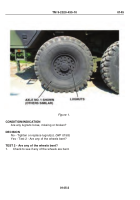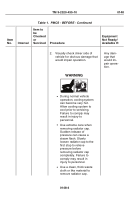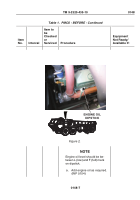TM-9-2320-435-10 - Page 898 of 1168
GENERAL MAINTENANCE PROCEDURE
•
Cleanliness:
Dirt, grease, oil, and debris only get in the way and may cover up a
serious problem. Use solvent cleaning compound (WP 0167, Table 1, Item 6, 7,
8, 9, 10, 11) on all metal surfaces and soapy water on rubber.
•
Bolts, Nuts, and Screws:
Check bolts, nuts, and screws for obvious looseness,
missing, bent, or broken condition and tighten or replace as necessary. They
cannot all be checked with a tool, of course, but look for chipped paint, bare metal,
or rust around bolt heads.
•
Welds:
Look for loose or chipped paint, rust, or gaps where parts are welded
together. If a bad weld is found, have it repaired.
•
Electric Wires and Connectors:
Look for cracked or broken insulation, bare
wires, and loose or broken connectors. Tighten loose connectors and make sure
wires are in good shape.
•
Hydraulic Lines and Fittings:
Look for wear, damage, and leaks, and make sure
clamps and fittings are tight. Wet spots show leaks, of course, but a stain around
a fitting or connector can indicate a leak. If a connector or fitting is loose, tighten
it. If something is broken or worn out, repair or replace per applicable procedure.
•
Damage is defined as:
Any conditions that affect safety or would render the
vehicle unserviceable for mission requirements.
FLUID LEAKAGE
It is necessary to know how fluid leakage affects the status of fuel, oil, coolant, and the
hydraulic systems. The following are definitions of types/classes of leakage necessary to
know in order to determine the status of the vehicle.
NOTE
Equipment operation is allowable with minor leakage (Class I or II).
Consideration must be given to the fluid capacity in the item/system being
checked/inspected. When in doubt, notify the supervisor. When operating
with Class I or II leaks, continue to check fluid levels as required in the
PMCS. Class III leaks should be repaired per applicable procedure.
Class I :
Seepage of fluid (as indicated by wetness or discoloration) not great enough to
form drops.
Class II:
Leakage of fluid great enough to form drops but not enough to cause drops to
drip from item being checked/inspected.
Class III:
Leakage of fluid great enough to form drops that fall from the item being checked/
inspected.
PREVENTIVE MAINTENANCE CHECKS AND SERVICES (PMCS)
Prior to performing your PMCS, check with your PLL clerk to verify that the latest
publications are being used.
TM 9-2320-435-10
0147
0147-2
Back to Top




















